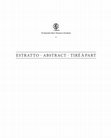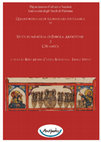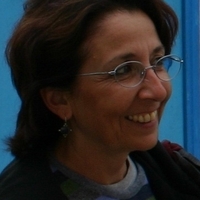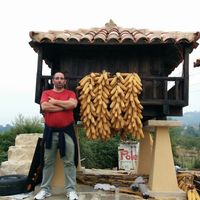Books by Bagnera Alessandra

Collections de l’ Ecole française de Rome, 2018
Connu depuis longtemps, l’exceptionnel complexe thermal de Cefalà, qui met en valeur une source c... more Connu depuis longtemps, l’exceptionnel complexe thermal de Cefalà, qui met en valeur une source chaude naturelle située à 30 km au sud de Palerme, n’avait jamais fait jusqu’à présent l’objet d’une étude systématique et interdisciplinaire qui exploite en particulier les données archéologiques recueillies lors des fouilles menées dans les années 1990 et 2000. Les résultats de la recherche menée sous l’égide de l’École française de Rome et en collaboration avec la Surintendance de Palerme à partir de 2003 ont permis de préciser la chronologie des bains, dont les origines oscillaient jusqu’ici entre Antiquité et époque normande, et d’éclairer pour la première fois leur articulation initiale avec le site au sein duquel ils se trouvaient. Construit à partir du Xe siècle sous la dynastie régionale kalbide dans le contexte de la Sicile fatimide, monumentalisé par la dynastie des Hauteville au milieu du XIIe siècle, le complexe a connu une utilisation et une fréquentation ininterrompue et en constante évolution jusqu’au XXe siècle, avant d’être étudié et protégé. Ses transformations reflètent celles qu’a connues la société sicilienne au cours du Moyen Âge et notamment l’effacement progressif du contexte islamique initial, puis la féodalisation tardo-médiévale et enfin la redécouverte du complexe par les érudits de l’époque moderne. Cet ouvrage synthétise nos connaissances actuelles sur ce témoin des origines islamiques d’une partie du patrimoine thermal, mais aussi architectural et plus largement culturel, sicilien et éclaire ainsi d’une lumière nouvelle l’histoire du Palermitain médiéval, mais aussi celle du thermalisme.
ACT Field School Reports and Memoirs, V , Sang-e-Meel Publications, Lahore 2015, 2015
Papers by Bagnera Alessandra
QDAP 12, 2018
Ceramica islamica a Palermo. La formazione di un orizzonte produttivo di Lucia Arcifa, Alessandra... more Ceramica islamica a Palermo. La formazione di un orizzonte produttivo di Lucia Arcifa, Alessandra Bagnera observations archéologiques et archéométriques sur les amphores globulaires de l'Afrique byzantine di Michel Bonifay, Claudio Capelli Fabiola Ardizzone: due saggi inediti di Maria Vittoria Fontana Ceramiche venete nelle Marche nei secoli XIII e XIV di Sauro Gelichi, Sergio Nepoti Ceramiche da mensa dal monastero benedettino di Monreale di Marco Manenti Nuovi dati sulle anfore di fine X-XI secolo dal relitto "A" di Lido Signorino (Marsala) di Filippo Pisciotta, Nicolas Garnier Le matrici culturali della ceramica comune medievale dallo scavo dell'Ipogeo P di Agrigento di Daniela Raia Le anfore prodotte a Palermo in eta' islamica: mercato urbano ed esportazioni di Viva Sacco Cefalù: testimonianze di cultura materiale dall'Alto Medioevo al XII secolo di Amedeo Tullio
The Aghlabids and their Neighbors, 2018

L. Arcifa, C. Rognoni (eds.), La Sicilia e il Mediterraneo dal Tardoantico al Medioevo. Prospettive di ricerca tra archeologia e storia, Atti del Convegno Internazionale di studi dedicato a Fabiola Ardizzone Lo Bue, Palermo, 2022
On the basis of different types of observations, the contribution intends to preliminarily propos... more On the basis of different types of observations, the contribution intends to preliminarily propose a new reading of Islamic Palermo aimed at the possibility of looking at the city of the tenth and eleventh centuries as an articulated set of elements of a different nature but converging within a single forma urbis. In particular, the analysis focuses on the areas commonly considered to be outside the city proper with the aim of providing a possible alternative interpretation, that is, to define their character as integral parts of the urban fabric.
The privileged point of observation will be provided by the realities that define
other large cities in the coeval Islamic world. The most recent acquisitions relating to the foundation processes, structuring methods and outcomes that characterise the latter between the 10th and first half of the 11th century offer interesting elements of comparison and important interpretative clues useful for framing the textual and material data available for Palermo from a different perspective.
The reconfiguration that affected Palermo in the 10th century through the direct intervention of the Fatimids gave rise to an entirely new urban entity, which as such must be looked at and analysed. Palermo should in fact be included, along with a conspicuous number of other cases, among the Islamic world's "great cities" known as "re-foundation cities", in which the nucleus of pre-Islamic origin was incorporated within a new urban structure that, albeit with different outcomes, appears to respond to principles not dissimilar to those governing contemporary ex-novo foundations. Looking at Palermo from this perspective allows us to turn our attention to a frame of reference that, declined on compatible spatial-temporal axes, will be of particular importance in the identification of some basic elements useful to support the need, as well as the possibility, of rereading in a different way both the layout and features of the capital of the emirate of Ṣiqilliyya.

L. Arcifa, M.R. Sgarlata (eds) From polis to madina. La trasformazione delle città siciliane tra tardo antico e alto medioevo, Atti del Convegno di Studi (Siracusa 21-23 giugno 2012), 2020
Conquered by the Aghlabids in 831, Islamic Palermo gradually took the shape of the important Medi... more Conquered by the Aghlabids in 831, Islamic Palermo gradually took the shape of the important Mediterranean capital that we find described
by the Arab geographers from the last quarter of the 10th century. We can assume, from the historical sources, that by the second half of the 9th century, at least, the ancient walled city of Panormos, to which the present Cassaro corresponds, had already undergone adaptations and modifications consequent to the new requirements of political, religious and social nature, as well as to its role as capital of the emirate of Sicily. Times and modes of the first interventions cannot currently be assessed, but it is nonetheless plausible to assert that the urban framework of early Islamic Palermo was essentially circumscribed within the ancient city, i.e. the madīna Balarm or Qaṣr al-qadīm of the Arabic geographers. It is, therefore, within the perimeter of its walls that evidence concerning the processes of transformation
from the Byzantine city to the Aghlabid capital should be searched and evaluated. Islamic Palermo, however, is also a city that at the turn of the first third of the 10th century experienced a process of reconfiguration due to direct intervention of the Fatimids. The foundation of the Khāliṣa (937-938) represented, indeed, a crucial turning-point in the history of its urban development, for it gave rise to the first planned expansion beyond the ancient fortified nucleus of madīna Balarm. By incorporating the latter, a new urban layout was progressively defined by the foundation of new quarters, thus originating the multinuclear structure that we find described by Ibn Ḥawqal (973) and then by the “Book of Curiosity” (mid-11th century). Created by the Fatimids and increased by the Kalbids (948-1040), this new urban entity might be looked upon as a city of new foundation, as a “re-founded city”. In order to situate it in this new perspective and with the questions raised by the structuring process of Islamic Palermo, we will look at the far-reaching implications resulting from the recent research on the medieval cities of the Maghreb and Ifrīqiya. This provides access to new evidence and suggests new methodological approaches regarding origin, morphology, environmental impact, integration into trade networks etc. of the cities founded, or “re-founded”, between the 9th and the 11th century in the western part of the dār al-islām.

A. Nef (ed.), A Companion to Medieval Palermo. The History of a Mediterranean City from 600 to 1500, Brill’s Companions to European History, 2013
Conquered by the Aghlabids in 831, Palermo gradually took the shape of the important Mediterranea... more Conquered by the Aghlabids in 831, Palermo gradually took the shape of the important Mediterranean capital we find described by the Arabic geographers from the last quarter of the 10th century. We can assume from the historical sources that at least by the second half of the 9th century the ancient walled city of Panormos - to which the present Cassaro corresponds - had already undergone adaptations and modifications consequent to the new requirements of political, religious and social nature, as well as to its role as capital of the Sicily emirate.
It was at the turn of the first third of the 10th century that Palermo experienced a real process of reconfiguration due to direct intervention of the Fatimids. The foundation of the Khāliṣa (937-938) represented indeed a crucial turning-point in the history of its urban development, for it gave rise to the first planned expansion beyond the ancient fortified nucleus of madīna Balarm. By incorporating the latter also, a new urban layout was progressively defined by the foundation of new quarters, thus originating the multinuclear structure we find described by Ibn Ḥawqal (973) and then by the “Book of Curiosity” (mid-11th century).

Archeologia Medievale, XLVII, p. 249-274, 2021
In this article we will examine a series of problems that emerged during two systematic campaigns... more In this article we will examine a series of problems that emerged during two systematic campaigns of archeometric analysis using optical and electronic microscopes to study the clays and, in particular, the glazes pertaining to 41 pottery samples datable to between the end of the 9th to the end of the 11th century which came from the stratigraphic sequences discovered in some excavations conducted in Palermo from the 1980s until 2000 (Castello-San Pietro; Gancia; Palazzo Bonagia). Despite the many archeometric studies focused on the petrographic definition of Palermitan pottery, no project has yet been directed to the systematic identification of the types of glazes used for this production, although in reality the specific study of these latter opens a whole new series of research possibilities that have important effects on the economic, social and methodological aspects. The technological definition of Palermitan pottery products is part of a wider context of the problems related to glazed ceramics in the Mediterranean area, consequently it is important to deal with them on an innovative basis which compares them with imports from North Africa and other contexts in the eastern areas. The technological characterization also requires a revision of the criteria used for classification which combines a chronological-typological approach with the archeometric data.

O. Grimm (ed.), Raptor on the fist – falconry its imagery and similar motifs throughout the millennia on a global scale, Advanced Studies on the Archaeology and History of hunting, 2020
With our present knowledge of the material culture of Islamic Sicily (c. 827–1040) we are able to... more With our present knowledge of the material culture of Islamic Sicily (c. 827–1040) we are able to approach the figurative themes in question only through a limited number of glazed ceramics with polychrome decoration produced between the 10th and first half of the 11th century, mostly in Palermo. In
no case do we observe iconographies connected with falconry, be it depictions of hunting with a falcon or simply of a raptor directly or indirectly associated with this specific activity. The features of the one
bird of prey represented, namely the eagle, suggest symbolic interpretation, probably of astronomic significance, while the first and only evidence of a falconer on horseback appears to date to the 12th century, and thus the Norman period. Our aim in this paper is to consider two particular issues that emerge from the picture outlined above: what significance are we to attribute to the only type of raptor depicted on glazed ceramic, i.e. the eagle? And how are we to account for the absence in the same period, apparently up to the 12th century, of figurative evidence of falconry? While, in the former case, we can offer a plausible answer on the basis of the available evidence involving significant connections with the contemporary Islamic world, the apparent disparity with this culture in the latter case leaves an open question.
Keywords: Islamic Sicily, glazed wares, raptor depiction, eagle constellation iconography, mounted falconer iconography

M. Chiovaro, R. Sapia (eds.) Studi in onore di Stefano Vassallo, Notiziario Archeologico della Soprintendenza di Palermo, 2020
Three polychrome lustreware fragments belonging to a single open form have been recognized among ... more Three polychrome lustreware fragments belonging to a single open form have been recognized among the Islamic ceramics retrieved from an archaeological sounding carried out by the Soprintendenza of Palermo in 1991 at Piazza Magione. Typological features and archaeometric analyses identify this specimen as belonging to the "family" of the polychrome lustrewares produced in Iraq in the IX-X century, and from there widely exported to many urban centers of the coeval Islamic world. Due to this first, important witness, also Palermo can be now included in the wide circulation network of the Iraqi lustrewares, realigning itself to the main Mediterranean cities. This also reinforces the hypothesis concerning that, as elsewhere, local glazed products may have referred to these high-quality ceramics in
some aspects, particularly the decorative ones.

R. M. Carra Bonacasa and E. Vitale (eds), Studi in Memoria di Fabiola Ardizzone, Quaderni Digitali di Archeologia Postclassica , 2018
This paper aims to a preliminary analysis of the Palermo ceramics productions, which, not atteste... more This paper aims to a preliminary analysis of the Palermo ceramics productions, which, not attested in the late IX-early X century contexts recently reviewed, can be dated from the immediately following period, namely during the tenth century. In continuity with the approach we used to examine the Islamization processes underlying the first productions (Arcifa and Bagnera 2018), useful elements are analyzed to allow the different registers and cultural influences composing the productive horizon of the capital of the Sicilian emirate to be highlighted. By focusing on some key arguments related both with the morphological and decorative repertoires and the manifacturing techniques as indicators of wider processes, new research paths emerge towards three main directions:
a) measuring the maintenance and / or changes of the previous, preislamic components within the new production framework, as well as the possible intervention of new inputs; b) to identify the main articulation features of the Palermo productions and workshops; c) to assess how and to what extent the productive reality of Palermo fits whithin the networks, circuits and relationships dynamics defining the main ceramic horizons of the 9th-10th century Islamic world.
KEYWORDS: Islamic Palermo pottery productions, pottery kilns typologies, painted
wares, glazed wares, Byzantin, Fatimid, Abbasid, East Mediterranean, Ifrīqiya, Iraq, Iran
Studi in memoria di Fabiola Ardizzone. 3. Ceramica, 2018
Terzo dei quattro QDAP (nn. 10-13) dedicati alla memoria di Fabiola Ardizzone da un folto gruppo ... more Terzo dei quattro QDAP (nn. 10-13) dedicati alla memoria di Fabiola Ardizzone da un folto gruppo di colleghi e allievi. Gli argomenti trattati sono stati suddivisi per tematiche: 1. Epigrafia e Storia; 2. Scavi, Topografia e Archeologia del paesaggio; 3. Ceramica; 4. Varie.
ISBN 978-88-99751-44-9 - ebook PDF - pp. 262

A. Bagnera, A. Nef (eds), Les Bains de Cefalà (Xe-XIXe siècle). Aux sources islamiques du thermalisme médiéval sicilien, Collections de l’Ecole française de Rome, 538, Rome, p. 60-174 , 2018
The exceptional thermal complex at Cefalà, which makes the most of a natural hot spring located 3... more The exceptional thermal complex at Cefalà, which makes the most of a natural hot spring located 30 km south of Palermo, has long been well known, but until now it had never been the subject of a systematic, interdisciplinary study based in particular on the archaeological data collected during the excavations carried out in the 1990s and 2000s. The results of the research carried out under the aegis of the École française de Rome and in collaboration with the Superintendency of Palermo from 2003 onwards have made it possible to clarify the chronology of the baths, whose origins had hitherto oscillated between Antiquity and the Norman period, and to shed light for the first time on their initial relationship with the site in which they were located. Built from the tenth century onwards under the regional Kalbid dynasty in the context of Fatimid Sicily, and monumentalised by the Hauteville dynasty in the mid-twelfth century, the complex was used and visited continuously and in constant evolution until the twentieth century, before being studied and protected. Its transformations reflect those experienced by Sicilian society during the Middle Ages, in particular the gradual disappearance of the initial Islamic context, followed by late-medieval feudalisation and, finally, the rediscovery of the complex by scholars in the modern era. This book summarises our current knowledge of this witness to the Islamic origins of part of Sicily's thermal, architectural and wider cultural heritage, and sheds new light on the history of medieval Palermo, as well as that of thermalism.
G. D. Anderson, C. Fenwick, M. Rosser-Owen (eds.), The Aghlabids and Their Neighbours. Art and Material Culture in Ninth-Century North Africa, Handbook of Oriental Studies (The Near and Middle East) 122, Brill, Leiden-Boston, 2018
Comment les Aghlabides ont-ils gouverné l'Ifriqiya ? 49 Mounira Chapoutot-Remadi 4 Reinterpreting... more Comment les Aghlabides ont-ils gouverné l'Ifriqiya ? 49 Mounira Chapoutot-Remadi 4 Reinterpreting the Aghlabids' Sicilian Policy (827-910) 76 Annliese Nef 5 Topographies of Power in Aghlabid-Era Kairouan 88 Caroline Goodson 6 L'atelier monétaire d'al-ʿAbbassiyya : du « vieux château » (al-Qasr al-Qadim) à la ville princière aghlabide 106 Abdelhamid Fenina 7 Le changement du type monétaire des dinars aghlabides sous le règne de Ziyadat Allah III : évolution ou révolution artistique ? 127 Mohamed Ghodhbane
Proceedings of the 6th International Congress of …, 2010
... Conclusion Recognizing the many precious elements useful in the definition of both the histor... more ... Conclusion Recognizing the many precious elements useful in the definition of both the historical events of the early Islamization of Swat and the material, socio-economical and cultural ... Manna, G. 2006 Some Observations on the Pottery from the Islamic Settlement of ...











Uploads
Books by Bagnera Alessandra
Papers by Bagnera Alessandra
The privileged point of observation will be provided by the realities that define
other large cities in the coeval Islamic world. The most recent acquisitions relating to the foundation processes, structuring methods and outcomes that characterise the latter between the 10th and first half of the 11th century offer interesting elements of comparison and important interpretative clues useful for framing the textual and material data available for Palermo from a different perspective.
The reconfiguration that affected Palermo in the 10th century through the direct intervention of the Fatimids gave rise to an entirely new urban entity, which as such must be looked at and analysed. Palermo should in fact be included, along with a conspicuous number of other cases, among the Islamic world's "great cities" known as "re-foundation cities", in which the nucleus of pre-Islamic origin was incorporated within a new urban structure that, albeit with different outcomes, appears to respond to principles not dissimilar to those governing contemporary ex-novo foundations. Looking at Palermo from this perspective allows us to turn our attention to a frame of reference that, declined on compatible spatial-temporal axes, will be of particular importance in the identification of some basic elements useful to support the need, as well as the possibility, of rereading in a different way both the layout and features of the capital of the emirate of Ṣiqilliyya.
by the Arab geographers from the last quarter of the 10th century. We can assume, from the historical sources, that by the second half of the 9th century, at least, the ancient walled city of Panormos, to which the present Cassaro corresponds, had already undergone adaptations and modifications consequent to the new requirements of political, religious and social nature, as well as to its role as capital of the emirate of Sicily. Times and modes of the first interventions cannot currently be assessed, but it is nonetheless plausible to assert that the urban framework of early Islamic Palermo was essentially circumscribed within the ancient city, i.e. the madīna Balarm or Qaṣr al-qadīm of the Arabic geographers. It is, therefore, within the perimeter of its walls that evidence concerning the processes of transformation
from the Byzantine city to the Aghlabid capital should be searched and evaluated. Islamic Palermo, however, is also a city that at the turn of the first third of the 10th century experienced a process of reconfiguration due to direct intervention of the Fatimids. The foundation of the Khāliṣa (937-938) represented, indeed, a crucial turning-point in the history of its urban development, for it gave rise to the first planned expansion beyond the ancient fortified nucleus of madīna Balarm. By incorporating the latter, a new urban layout was progressively defined by the foundation of new quarters, thus originating the multinuclear structure that we find described by Ibn Ḥawqal (973) and then by the “Book of Curiosity” (mid-11th century). Created by the Fatimids and increased by the Kalbids (948-1040), this new urban entity might be looked upon as a city of new foundation, as a “re-founded city”. In order to situate it in this new perspective and with the questions raised by the structuring process of Islamic Palermo, we will look at the far-reaching implications resulting from the recent research on the medieval cities of the Maghreb and Ifrīqiya. This provides access to new evidence and suggests new methodological approaches regarding origin, morphology, environmental impact, integration into trade networks etc. of the cities founded, or “re-founded”, between the 9th and the 11th century in the western part of the dār al-islām.
It was at the turn of the first third of the 10th century that Palermo experienced a real process of reconfiguration due to direct intervention of the Fatimids. The foundation of the Khāliṣa (937-938) represented indeed a crucial turning-point in the history of its urban development, for it gave rise to the first planned expansion beyond the ancient fortified nucleus of madīna Balarm. By incorporating the latter also, a new urban layout was progressively defined by the foundation of new quarters, thus originating the multinuclear structure we find described by Ibn Ḥawqal (973) and then by the “Book of Curiosity” (mid-11th century).
no case do we observe iconographies connected with falconry, be it depictions of hunting with a falcon or simply of a raptor directly or indirectly associated with this specific activity. The features of the one
bird of prey represented, namely the eagle, suggest symbolic interpretation, probably of astronomic significance, while the first and only evidence of a falconer on horseback appears to date to the 12th century, and thus the Norman period. Our aim in this paper is to consider two particular issues that emerge from the picture outlined above: what significance are we to attribute to the only type of raptor depicted on glazed ceramic, i.e. the eagle? And how are we to account for the absence in the same period, apparently up to the 12th century, of figurative evidence of falconry? While, in the former case, we can offer a plausible answer on the basis of the available evidence involving significant connections with the contemporary Islamic world, the apparent disparity with this culture in the latter case leaves an open question.
Keywords: Islamic Sicily, glazed wares, raptor depiction, eagle constellation iconography, mounted falconer iconography
some aspects, particularly the decorative ones.
a) measuring the maintenance and / or changes of the previous, preislamic components within the new production framework, as well as the possible intervention of new inputs; b) to identify the main articulation features of the Palermo productions and workshops; c) to assess how and to what extent the productive reality of Palermo fits whithin the networks, circuits and relationships dynamics defining the main ceramic horizons of the 9th-10th century Islamic world.
KEYWORDS: Islamic Palermo pottery productions, pottery kilns typologies, painted
wares, glazed wares, Byzantin, Fatimid, Abbasid, East Mediterranean, Ifrīqiya, Iraq, Iran
ISBN 978-88-99751-44-9 - ebook PDF - pp. 262
The privileged point of observation will be provided by the realities that define
other large cities in the coeval Islamic world. The most recent acquisitions relating to the foundation processes, structuring methods and outcomes that characterise the latter between the 10th and first half of the 11th century offer interesting elements of comparison and important interpretative clues useful for framing the textual and material data available for Palermo from a different perspective.
The reconfiguration that affected Palermo in the 10th century through the direct intervention of the Fatimids gave rise to an entirely new urban entity, which as such must be looked at and analysed. Palermo should in fact be included, along with a conspicuous number of other cases, among the Islamic world's "great cities" known as "re-foundation cities", in which the nucleus of pre-Islamic origin was incorporated within a new urban structure that, albeit with different outcomes, appears to respond to principles not dissimilar to those governing contemporary ex-novo foundations. Looking at Palermo from this perspective allows us to turn our attention to a frame of reference that, declined on compatible spatial-temporal axes, will be of particular importance in the identification of some basic elements useful to support the need, as well as the possibility, of rereading in a different way both the layout and features of the capital of the emirate of Ṣiqilliyya.
by the Arab geographers from the last quarter of the 10th century. We can assume, from the historical sources, that by the second half of the 9th century, at least, the ancient walled city of Panormos, to which the present Cassaro corresponds, had already undergone adaptations and modifications consequent to the new requirements of political, religious and social nature, as well as to its role as capital of the emirate of Sicily. Times and modes of the first interventions cannot currently be assessed, but it is nonetheless plausible to assert that the urban framework of early Islamic Palermo was essentially circumscribed within the ancient city, i.e. the madīna Balarm or Qaṣr al-qadīm of the Arabic geographers. It is, therefore, within the perimeter of its walls that evidence concerning the processes of transformation
from the Byzantine city to the Aghlabid capital should be searched and evaluated. Islamic Palermo, however, is also a city that at the turn of the first third of the 10th century experienced a process of reconfiguration due to direct intervention of the Fatimids. The foundation of the Khāliṣa (937-938) represented, indeed, a crucial turning-point in the history of its urban development, for it gave rise to the first planned expansion beyond the ancient fortified nucleus of madīna Balarm. By incorporating the latter, a new urban layout was progressively defined by the foundation of new quarters, thus originating the multinuclear structure that we find described by Ibn Ḥawqal (973) and then by the “Book of Curiosity” (mid-11th century). Created by the Fatimids and increased by the Kalbids (948-1040), this new urban entity might be looked upon as a city of new foundation, as a “re-founded city”. In order to situate it in this new perspective and with the questions raised by the structuring process of Islamic Palermo, we will look at the far-reaching implications resulting from the recent research on the medieval cities of the Maghreb and Ifrīqiya. This provides access to new evidence and suggests new methodological approaches regarding origin, morphology, environmental impact, integration into trade networks etc. of the cities founded, or “re-founded”, between the 9th and the 11th century in the western part of the dār al-islām.
It was at the turn of the first third of the 10th century that Palermo experienced a real process of reconfiguration due to direct intervention of the Fatimids. The foundation of the Khāliṣa (937-938) represented indeed a crucial turning-point in the history of its urban development, for it gave rise to the first planned expansion beyond the ancient fortified nucleus of madīna Balarm. By incorporating the latter also, a new urban layout was progressively defined by the foundation of new quarters, thus originating the multinuclear structure we find described by Ibn Ḥawqal (973) and then by the “Book of Curiosity” (mid-11th century).
no case do we observe iconographies connected with falconry, be it depictions of hunting with a falcon or simply of a raptor directly or indirectly associated with this specific activity. The features of the one
bird of prey represented, namely the eagle, suggest symbolic interpretation, probably of astronomic significance, while the first and only evidence of a falconer on horseback appears to date to the 12th century, and thus the Norman period. Our aim in this paper is to consider two particular issues that emerge from the picture outlined above: what significance are we to attribute to the only type of raptor depicted on glazed ceramic, i.e. the eagle? And how are we to account for the absence in the same period, apparently up to the 12th century, of figurative evidence of falconry? While, in the former case, we can offer a plausible answer on the basis of the available evidence involving significant connections with the contemporary Islamic world, the apparent disparity with this culture in the latter case leaves an open question.
Keywords: Islamic Sicily, glazed wares, raptor depiction, eagle constellation iconography, mounted falconer iconography
some aspects, particularly the decorative ones.
a) measuring the maintenance and / or changes of the previous, preislamic components within the new production framework, as well as the possible intervention of new inputs; b) to identify the main articulation features of the Palermo productions and workshops; c) to assess how and to what extent the productive reality of Palermo fits whithin the networks, circuits and relationships dynamics defining the main ceramic horizons of the 9th-10th century Islamic world.
KEYWORDS: Islamic Palermo pottery productions, pottery kilns typologies, painted
wares, glazed wares, Byzantin, Fatimid, Abbasid, East Mediterranean, Ifrīqiya, Iraq, Iran
ISBN 978-88-99751-44-9 - ebook PDF - pp. 262
Palermo, 11-13 ottobre 2018